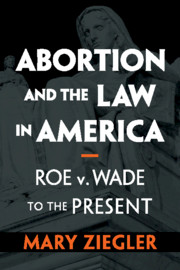Book contents
- Abortion and the Law in America
- Abortion and the Law in America
- Copyright page
- Dedication
- Contents
- Acknowledgments
- Timeline
- Abbreviations
- Introduction
- 1 Roe v. Wade and the Rise of Rights Arguments
- 2 The Hyde Amendment and Its Aftermath
- 3 Launching a Quest to Reverse Roe
- 4 Planned Parenthood v. Casey, the Family, and Equal Citizenship
- 5 Contesting the Relationship between Abortion and Health Care
- 6 Partial-Birth Abortion and Who Decides the Costs and Benefits
- 7 Polarization, Religious Liberty, and the War on Women
- Conclusion
- Notes
- Index
6 - Partial-Birth Abortion and Who Decides the Costs and Benefits
Published online by Cambridge University Press: 28 February 2020
- Abortion and the Law in America
- Abortion and the Law in America
- Copyright page
- Dedication
- Contents
- Acknowledgments
- Timeline
- Abbreviations
- Introduction
- 1 Roe v. Wade and the Rise of Rights Arguments
- 2 The Hyde Amendment and Its Aftermath
- 3 Launching a Quest to Reverse Roe
- 4 Planned Parenthood v. Casey, the Family, and Equal Citizenship
- 5 Contesting the Relationship between Abortion and Health Care
- 6 Partial-Birth Abortion and Who Decides the Costs and Benefits
- 7 Polarization, Religious Liberty, and the War on Women
- Conclusion
- Notes
- Index
Summary
Examining the years from 1995 to 2007, Chapter 6 studies how those on opposing sides fought about ways to measure the costs and benefits of abortion when experts disagreed. In this period, larger pro-life groups sponsored a ban on partial-birth abortion. At the start, NRLC mostly urged voters to rely on their own moral compass to see that the procedure should be illegal. Drawing on support from medical experts, abortion-rights supporters responded that dilation and extraction sometimes best protected women’s health. Abortion foes responded that both the mainstream media and organizations like the American College of Obstetricians and Gynecologists were biased. Since the debate turned partly on the costs of abortion (and abortion restrictions) for women, those on opposing sides increasingly fought about what should happen when experts disagreed. Should voters, experts, or individual patients have the final say when a scientific matter was in dispute? How should courts even define scientific uncertainty? Discussion of these questions reflected a larger national conversation about the line between politics and science.
Keywords
- Type
- Chapter
- Information
- Abortion and the Law in AmericaRoe v. Wade to the Present, pp. 150 - 180Publisher: Cambridge University PressPrint publication year: 2020

